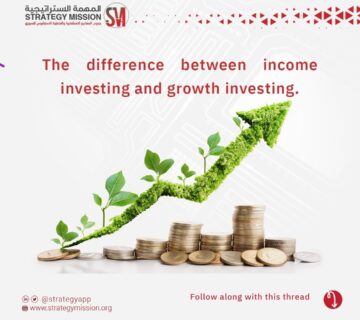There are several important marketing indicators that must be monitored when investing in marketing. Investing in marketing does not simply mean putting out specific content with some designs and waiting for organic reach to create results (although content can work wonders, this is often not the case with direct marketing content for products and services, but rather with entertaining, shocking, or informational content)
What we mean here are the metrics that must be continuously measured when launching your funded (paid) campaigns—whether they are paid social media campaigns for greater reach, influencer campaigns, email campaigns, or any other campaign where you pay for advertising and unnatural reach, etc.
Marketing terms related to investing in advertising campaigns are essential concepts that any marketer or advertiser must understand. Here are some of the common and fundamental terms:
(marketing indicators)
#ROI (Return on Investment):
A measure used to evaluate the effectiveness of an investment. It is calculated by taking the return (or profit) from the investment and dividing it by the original cost of the investment.
#ROAS (Return on Ad Spend):
A metric for evaluating the effectiveness of advertising campaigns. It is calculated by dividing the revenue brought in from the advertisement by the total cost of the advertisement.
#PPC (Pay-Per-Click):
An advertising model where the advertiser pays for each click on their advertisement.
#CPM (Cost Per Thousand Impressions):
Related to the cost of the advertisement appearing one thousand times.
#CPC (Cost Per Click):
The amount an advertiser pays for each actual click on their advertisement.
#CPA (Cost Per Acquisition):
The amount an advertiser pays when a user takes a specific action, such as registering or making a purchase.
#CLV أو #LTV (Customer Lifetime Value):
The estimated financial value that a customer will bring to the company over the duration of their relationship with the company.
#CTR (Click-Through Rate):
The percentage of clicks compared to the number of impressions.
#Conversion Rate (Conversion Rate):
The percentage of visitors who take a specific action (such as making a purchase or registering) out of the total number of visitors.
All the previously mentioned indicators are part of a large number of measurable metrics within performance evaluation criteria.
#KPI (Key Performance Indicator):
Indicators used to measure the performance of campaigns and the achievement of goals.
What is the Difference Between ROI and ROAS? With Example
The difference between ROI (Return on Investment) and ROAS (Return on Ad Spend) lies in the variables considered in each calculation and the purpose of each evaluation. Let’s look at each one individually:
– ROI (Return on Investment):
This is a general measure used to evaluate the effectiveness of an investment.
The formula: (Profit – Initial Cost) / Initial Cost
Example: If you invest $1,000 in a campaign and receive a return of $1,500, the ROI is \((1500 – 1000) / 1000 = 0.5\) or 50%.
– ROAS (Return on Ad Spend):
This measures the direct return from advertising campaigns.
The formula: Revenue from Ads / Total Cost of Ads
Example: If you spend $100 on an ad and it brings in $400 in sales, the ROAS is \(400 / 100 = 4\).
Key Difference:
While ROI provides a general overview of the overall effectiveness of an investment, ROAS focuses specifically on the direct return from advertisements.
Advice:
In the world of digital marketing, it is crucial to understand these metrics and use them correctly to ensure you get the maximum possible value from your investments.
Two marketing metrics that might cause confusion are PPC and CPM. Let’s delve into understanding these two terms and the differences between them.
PPC (Pay-Per-Click):
PPC is an advertising model that allows advertisers to pay a certain amount for each click (view) on their ad.
Example: If you create an ad and set the cost per click at $1, and 100 people click on it, you will pay $100. This system is typically used in advertising through social media networks, Google, etc.
CPM (Cost Per Thousand Impressions):
CPM is based on the number of times the ad is displayed, where the advertiser pays for every 1000 impressions of their ad.
Example: If the cost of CPM is $5 and your ad appeared 10,000 times, you will pay $50. This is typically available through tools like LinkedIn’s network.
Key Difference:
In PPC, you pay when the ad is interacted with through clicks, whereas in CPM, you pay based on the spread and appearance of your ad, regardless of the number of clicks you receive.
In reality, the effectiveness of both models (PPC and CPM) depends on the objectives of your advertising campaign and the target audience. Let’s review the benefits and potential uses of each model:
1-PPC (Pay-Per-Click):
*Benefits:
– Cost: You only pay when someone clicks on the ad, which can be cost-effective if clicks convert into actual customers.
– Focus: You can target a specific audience more effectively and optimize the ad based on performance.
– When to choose it: If you aim to achieve specific conversions such as sales, registrations, or downloads. If you are in a highly competitive field and want to ensure your budget is invested in an audience that actually engages.
2-CPM (Cost Per Thousand Impressions):
*Benefits:
– Awareness: Suitable for increasing brand or product awareness, as ads are displayed to a large number of people.
– Cost: In some cases, CPM may be less expensive, especially if you have an engaging ad with a high click-through rate.
– When to choose it: If your goal is to increase brand awareness or reach as many people as possible. If you are launching a new product or trying to reach a new audience.
In Conclusion: The choice between PPC and CPM depends on your specific goals and target audience. It’s always preferable to experiment with both models and monitor performance to determine the most suitable one for your campaign.
To request services for strategic analysis, marketing and sales plans, economic feasibility studies, and investment profile preparation, use the following form:
marketing indicators
marketing indicators
marketing indicators
marketing indicators
marketing indicators
marketing indicators
marketing indicators
marketing indicators





No comment